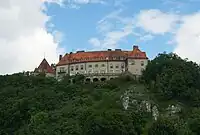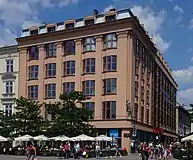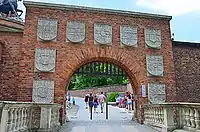Adolf Szyszko-Bohusz | |
|---|---|
 Adolf Szyszko-Bohusz (ca. 1927) | |
| Born | September 1, 1883 |
| Died | October 1, 1948 (aged 65) |
| Nationality | Polish |
| Alma mater | Saint Petersburg Academy of Arts |
| Occupation(s) | architect, preservationist |
| Spouse | Stefania (née Rzepko-Łaska) |
| Children | 1 daughter (Sława) |
| Parent(s) | Polikarp Szyszko-Bohusz (father) Marcelina (née Rząśnicka) (mother) |
| Buildings | Presidential Castle in Wisła Feniks House in Kraków PKO BP Building in Kraków |
Adolf Szyszko-Bohusz (1 September 1883, in Narva – 1 October 1948, in Kraków) was a Polish architect and conservator of monuments, a leading representative of historicism and modernism in Poland.
Life and career
He was born on 1 September 1883 in Narva, Russian Empire (present-day Estonia) to parents Polikarp Szyszko-Bohusz and mother Marcelina (née Rząśnicka).
Between 1902 and 1909, he studied in Saint Petersburg, later also in Austria in Germany. In 1910 Szyszko-Bohusz began lecturing at the Jagiellonian University and at the Jan Matejko Academy of Fine Arts in Krakow. In 1912 he moved to Lwow, to lecture at the Lviv Polytechnic, where he remained until 1916.[1]
Upon returning to Krakow, in 1916, Szyszko-Bohusz was given the post of the director of renovation crew of the Wawel Castle. Due to his efforts, several buildings as well as rooms of the castle were remodelled and renewed. He discovered remnants of the Romanesque prince’s palladium in front of the northern elevation of the castle (1921). In the years 1935–1938 he conducted restoration works in the western part of the cathedral. It was at that time that in St. Leonard's Crypt bishop Maurus’s tomb was found (d. 1118), as well as several fragments of the walls of the Romanesque cathedral and traces of its sequence of transformations. He created the sarcophagus of Juliusz Słowacki and helped with creation of the crypt of Jozef Pilsudski.[2]
In 1920, Szyszko-Bohusz became director of Department of Antique Architecture at the Academy of Fine Arts, and two years later he became rector of the college. Between 1932 and 1939, he was a director of the Architecture Department at the Warsaw University of Technology.
Szyszko-Bohusz was also a renowned architect. He designed his own family villa in Przegorzały,[3] the monumental office of the Krakow’s branch of PKO Bank Polski (1924) and several other buildings in Krakow. He designed the Castle of the President of Poland in the town of Wisla and the House of Health in Zakopane. Also, Szyszko-Bohusz was editor of the Architekt monthly.[4]
During World War II, Szyszko-Bohusz, with permission of the Home Army, worked in a private German architectural office, and in 1945 he returned to his post at the Wawel Castle. In the same year, he co-created Architecture Department at the AGH University of Science and Technology.[5]
He died on 1 October 1948 and was buried at the Rakowicki Cemetery in Krakow.
Honours
- Commander's Cross with Star of the Order of Polonia Restituta (1938)[6]
- Commander's Cross of the Order of Polonia Restituta (1928)[7]
- Officer's Cross of the Order of Polonia Restituta (1921)[8]
Gallery
_w_Wi%C5%9Ble_2.JPG.webp) Presidential Castle, Wisła
Presidential Castle, Wisła
_Villa%252C_13a_Jodlowa_street%252C_Przegorzaly%252C_Krakow%252C_Poland.jpg.webp) Baszta Villa, Kraków
Baszta Villa, Kraków Przegorzały Castle
Przegorzały Castle.jpg.webp) Church of Saints Peter and Paul, Terebovlia, Ukraine
Church of Saints Peter and Paul, Terebovlia, Ukraine Feniks House, Kraków
Feniks House, Kraków Wawel Coat of Arms Gate, Kraków
Wawel Coat of Arms Gate, Kraków%252C_7_Mariacki_square%252C_Old_Town%252C_Krakow%252C_Poland.jpg.webp) Tenement house at 7 Mariacki Square, Old Town, Kraków
Tenement house at 7 Mariacki Square, Old Town, Kraków
References
- ↑ "Adolf Szyszko-Bohusz". Retrieved 2019-08-24.
- ↑ "Wawel średniowieczny. Adolf Szyszko-Bohusz". Retrieved 2019-08-24.
- ↑ "Krakowski Szlak Modernizmu". Archived from the original on 2019-08-24. Retrieved 2019-08-24.
- ↑ "Adolf Szyszko-Bohusz". Retrieved 2019-08-24.
- ↑ "Adolf Szyszko-Bohusz". Retrieved 2019-08-24.
- ↑ "M.P. 1938 nr 258 poz. 592". Archived from the original on 2019-10-09. Retrieved 2019-08-24.
- ↑ "Kurjer Warszawski : wydanie wieczorne. R. 108, 1928, nr 134". Retrieved 2019-08-24.
- ↑ "Order Odrodzenia Polski. Trzechlecie Pierwszej Kapituły 1921-1924". Retrieved 2019-08-24.